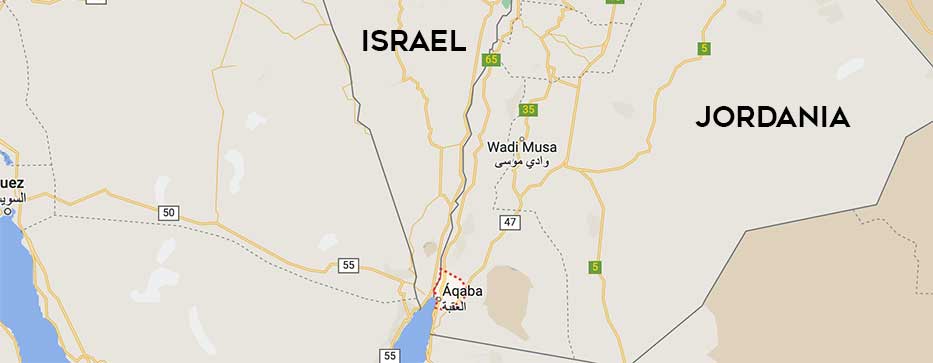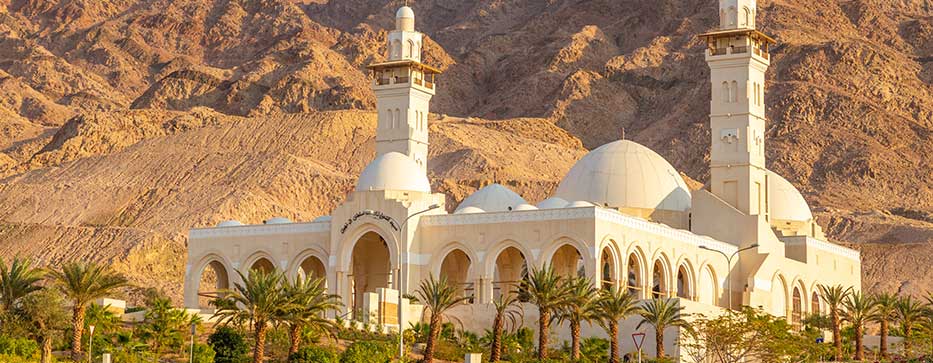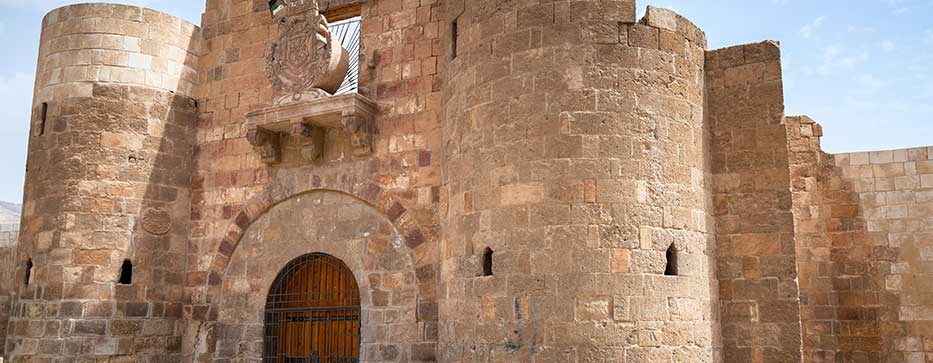You only have to take a walk to see that Aqaba it is a city unlike any other city in Jordan. This is because of its special location on the Red Sea coast, but also because of its orderly appearance, its cosmopolitan air and its strong commitment to tourism as a great economic engine. On this page we offer you a small guide, in which you will discover what to see in Aqaba, how to get there and other details of interest for your trip.
Aqaba is a city of about 170,000 inhabitants (and growing), capital of the governorate of the same name. Although it may seem a not very high figure, it is one of the 10 most populated in the country but, above all, it is the most important at a strategic level, due to the geographical location it occupies.
It is located on the coast of the Red Sea, in the center of the Gulf of Aqaba. It is the only landlocked Jordanian city (since the
Dead Sea
is actually an endorheic lake and is not navigable). Since the Jordanian coastline is very small, barely 26 km, all maritime activity is concentrated here.
From a tourist point of view, the location of Aqaba is also interesting because of its proximity to two borders: the Israeli and the Saudi. Above all, with the first: the border post of Eilat, to the west, is an important gateway for travelers who make a
combined circuit with Israel or even with Egypt
. The border post with Saudi Arabia, to the south, is less used by tourists.
Its climate is warm throughout the year: in summer, it can be said that it is “very warm” if we look at the figures that mark the thermometers (above 40ºC, which forces you to seek refuge in the central hours of the day), but thanks to a slight sea breeze, the feeling is not as suffocating as in other parts of the desert, For example.
On the other hand, winters are really pleasant, to the point of attracting sun and beach tourism that other Mediterranean destinations cannot assume: with temperatures exceeding 20ºC in January and February, there are many tourists who come here in that period, attracted not only by the sun and heat, but also by other claims that we show below.
Rainfall, in addition, is practically non-existent, even in winter, with an average of 9 rainy days per year. Therefore, coming to Aqaba to enjoy the Red Sea is a safe bet, whatever the season.

The city of Aqaba, known centuries before Christ as Elath, Ailath or Ayla, was a strategic point from its beginnings. Already in the tenth century BC, King Solomon made use of this space to transport to other places copper, extracted in the mines of Wadi Araba. Chinese ceramics and Ethiopian coins have also been found in the area, which accounts for the commercial nature of this enclave.
A similar use was given by the civilizations that later dominated Ayla: Egyptians, Nabataeans and, above all, Romans from 106 AD, as well as their Byzantine heirs. The existence of several churches, some of them really old (III century), would confirm its good position and dynamism, with its own bishopric. The city fell into Arab hands around 630, becoming in the following centuries a place of obligatory passage for the Egyptians on pilgrimage to Mecca.
However, Aqaba entered a phase of great decline from the eleventh century. First, by a devastating earthquake in the middle of that century. And secondly because the great trade routes began to have Baghdad as their epicenter, relegating this route to a secondary role.
In the twelfth century, the conquest of Baldwin I’s crusaders and the subsequent reconquest by Saladin’s troops also did not help to create a climate of stability for trade, so that Aqaba was relegated to little more than a fishing village.
The Ottomans, dominators of the area for almost five centuries, did not reverse the situation of the city (despite important projects such as the expansion of its Fort), which saw how two alternative communication routes were opened: for trade, through the Suez Canal, operational since the mid-nineteenth century, and for pilgrims to Mecca, with the Hejaz railway at the beginning of the twentieth century (although its period of operation was fleeting).
However, Aqaba would feature prominently in another historical episode in Jordan: the Arab Rebellion. The Ottoman Empire had given it a strategic military role, but it was taken by the British and Arabs (with a key role of Thomas Edward Lawrence or Lawrence of Arabia), in one of the most transcendental chapters of that movement.
When Jordan’s independence came in 1946, Aqaba’s coastline was only about 14 km long, something that neighboring Saudi Arabia certainly did not recognize. But in 1965, King Hussein made an exchange of land, which earned him official recognition and the expansion of the Jordanian coast: another 12 km, in exchange for 6,000 km2 in the desert.
At present, Aqaba is a prosperous city that advances thanks to the important tourism that stops here, largely of premium level. This can be seen in the high concentration of private urbanizations, resorts and hotels that exist, especially in the coastal area, where other spaces of the highest level are located, such as its marina and its water park. In parallel, its strategic location on the Red Sea highlights the importance of Aqaba in other sectors, such as logistics thanks to its goods port, or real estate, thanks to its new developments.

Although it may not seem like the most picturesque city and many travelers come here in search of relaxation, there are also many things to see in Aqaba. Some are historical sites and monuments, while others are claims of recent creation but of maximum interest.
The prosperity of ancient Ayla can still be seen in some historical monuments and archaeological sites scattered around the city. If you are interested in this topic, you can take note of the following places What to see in Aqaba:

Without having to go back in time, there are many other attractions to see in Aqaba, as they are authentic icons of the city. The first of these is the flag of the Arab Revolt: in reality, you will not have much difficulty seeing it… it is visible from many places in the city and even from outside it! Its flagpole has a height of 137 meters high, while the flag itself measures 20 x 40 meters. He settled here in 2017, to commemorate the Great Arab Rebellion against the Turks. That is why the flag is not exactly the Jordanian one, but that of the aforementioned revolutionary movement, since the seven-pointed star, distinctive of the Jordanian flag, is missing. It is, therefore, a reaffirmation of what happened here 100 years earlier, declaring the Arab identity of the country.
In the section of mosques, Aqaba has several of great interest. The most important is perhaps that of Sharif Al Hussein Bin Ali, promoted by the great-great-grandfather of King Abdullah II and a key figure in the Arab Rebellion. It is elegant and immaculate, with an Ottoman-style minaret visible on its coastline.
And to discover all the underwater wealth of the Red Sea without having to leave the city, nothing better than going to the Aqaba Aquarium. It is located very close to the ferry terminal, about 10 km south of the city. Perhaps for this reason it may go unnoticed by many travelers, but the marine species that swim here make the visit worthwhile: pterois, parrotfish, turtles … and a long etcetera.
Finally, if all you want is to stroll quietly through Aqaba, you can go to Al-Hammamat Al-Tunisiyah St. (continuation of Ash Sherif Al Hussein Bin Ali St. or simply Amman Hwy), connecting Ayla Circle and Prs. Haya Circle: here you will find one of the central parks of the city, as well as a shopping area in Aqaba Gateway, to finish the walk in the always pleasant marina.

Not only will you have things to see in Aqaba, but also things to do. It is one of the most dynamic cities in terms of activities, since it has something that no other Jordanian city has: the sea. Therefore, some of the most interesting proposals have to do with it. Especially:
If you take a walk around the center, there is more to see that Aqaba It has a considerable variety of restaurants and shops, superior to that of other cities of similar size. Therefore, it is possible to take a walk around the center to enjoy a good purchase or a good dinner. Among the whims you can buy are textile products (Arab scarves, carpets, etc.) or ostrich eggs, while to eat something characteristic of the city you can go to King Hussein St. and Raghadan St.
The tourist success of Aqaba is not only due to its excellent location, but also to its good communications network, better and more efficient than in other cities of the country. One of Jordan’s two international airports is located here: although it has less air traffic and fewer connections to other countries than Amman, it is usually heavily used by charter flights. In addition, it has a direct route to Amman International Airport, so flying from one city to another is feasible, which is a way to speed up travel.
Aqaba also has an important ferry station, mainly used to connect the city with the Sinai Peninsula in Egypt. The most popular route is Nuweiba, with regular lines, but there is another with Taba, shorter and faster, by private catamarans.
Long-distance buses also have Aqaba as one of the most important points of the network. With the company JETT you can travel to Wadi Musa (Petra), Wadi Rum or Amman, as well as to other less touristy but very populated cities, such as Zarqa or Irbid.
And if you opt for transport with a private vehicle (car or bus), which is always the most comfortable and flexible, you must calculate the following distances and durations for the journey:
Once in Aqaba, you have different options to get around. If what you need is a transfer from the airport, there is only the option of collective taxi or private service, as there are no shuttle buses. The airport is located about 10 km to the north, which is about 15 minutes away.
Something similar happens with the ferry terminal, at a similar distance but from the south. In this case, there are no shuttle buses either, although there are minibuses. The option of taxi or private vehicle is again the most convenient.
And to get around the city, you’ll find green taxis without a meter, so you’ll need to negotiate every race.
For more information on what to see in Aqaba You can go to their tourist information office. It is located in Ayla Circle and has brochures, maps and other updated materials for tours in the city.
Being a modern and large city, Aqaba also has other services of interest to tourists, such as a police station in front of the bus station and a modern and well-equipped hospital in the center.





